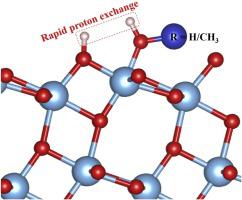Applied Catalysis B: Environment and Energy ( IF 22.1 ) Pub Date : 2020-06-19 , DOI: 10.1016/j.apcatb.2020.119234 Yukun Zhao , Tao Shi , Jinting Shang , Liyong Ding , Xingzhong Cao , Chuncheng Chen , Jincai Zhao

|
Understanding the interactions of adsorbed molecules with TiO2 surfaces is important for diverse applications, such as photocatalysis and self-cleaning surfaces. Herein, we investigated the interactions of adsorbed molecules with surface sites on TiO2. The 1H NMR spectra showed that surface healing led to an interesting upfield shift in the chemical shifts of hydroxyls of adsorbed molecules, which is caused by rapid proton exchange between the defect-involved bridging hydroxyls and adsorbed molecules. Infrared spectroscopy confirmed that surface healing decreases the number of surface hydroxyl groups and enhances the number of non-defective surface Ti sites required for methanol adsorption. Therefore, we proposed that undissociative adsorption of methanol is the preferential interaction mode with the non-defective sites of the TiO2 surface but dynamic equilibrium between dissociative and undissociative adsorption exists around surface defect sites. The increase in non-defective surface sites enhanced the surface ζ potential and hindered interfacial electron transfer activity.
中文翻译:

表面桥接羟基与TiO 2上吸附分子之间的快速质子交换
了解吸附分子与TiO 2表面的相互作用对于多种应用(例如光催化和自清洁表面)很重要。在这里,我们研究了被吸附的分子与TiO 2表面位点的相互作用。在11 H NMR光谱表明,表面修复导致吸附分子的羟基的化学位移发生有趣的高场位移,这是由缺陷参与的桥连羟基与吸附分子之间的快速质子交换引起的。红外光谱证实表面修复减少了表面羟基的数目,并增加了甲醇吸附所需的无缺陷的表面Ti位点的数目。因此,我们提出甲醇的非离解吸附是与TiO 2的非缺陷部位的优先相互作用方式。表面缺陷,但在表面缺陷位点附近存在解离吸附和非解离吸附之间的动态平衡。无缺陷表面位点的增加增强了表面ζ电势并阻碍了界面电子转移活性。


























 京公网安备 11010802027423号
京公网安备 11010802027423号